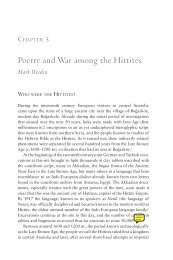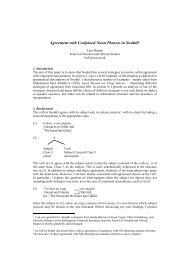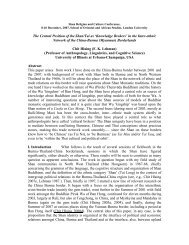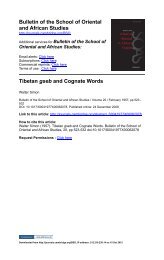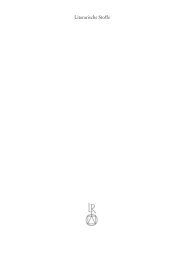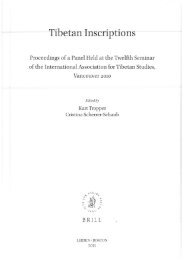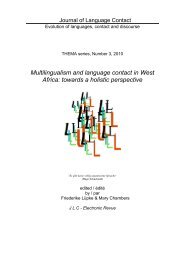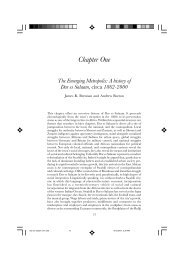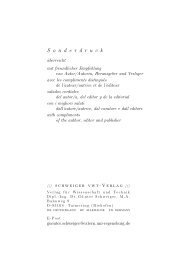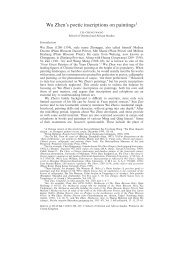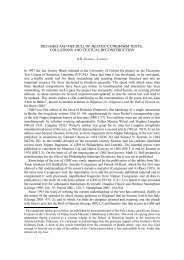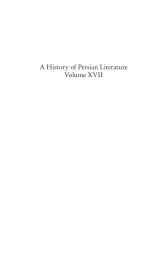In search of the é . d u b . b a . a : the ancient Mesopotamian school ...
In search of the é . d u b . b a . a : the ancient Mesopotamian school ...
In search of the é . d u b . b a . a : the ancient Mesopotamian school ...
Create successful ePaper yourself
Turn your PDF publications into a flip-book with our unique Google optimized e-Paper software.
George/4<br />
learner scribes. <strong>In</strong> <strong>the</strong> latter about four hundred similar tablets came to light, most in<br />
secondary contexts as fill. Both houses were described by Woolley as ‘<strong>school</strong>s’. He went<br />
so far as to style <strong>the</strong> man he supposed was <strong>the</strong> occupant <strong>of</strong> No. 1 Broad Street, a certain<br />
Igmil-Sîn, as <strong>the</strong> ‘headmaster <strong>of</strong> a boys’ <strong>school</strong>’ (Woolley 1963: 185), a description that,<br />
coming from such a source, might conjure up in <strong>the</strong> impressionable mind a vision <strong>of</strong> an<br />
English public <strong>school</strong> complete with junior masters, tuck shops and rugby football<br />
pitches.<br />
Woolley would not have intended such an understanding but he was jumping to<br />
unwarranted conclusions, none<strong>the</strong>less. The two houses <strong>of</strong> Ur and <strong>the</strong> finds made in <strong>the</strong>m<br />
have been exhaustively studied by Dominique Charpin (Charpin 1986: 419–86). He has<br />
shown that, as with House F in Area TA at Nippur, we are dealing with private dwellinghouses<br />
that belonged to men <strong>of</strong> <strong>the</strong> literate, priestly class. Charpin’s conclusions are that<br />
No. 7 Quiet Street was certainly a venue <strong>of</strong> scribal education, though a modest one;<br />
however, it is unsafe to assume that No. 1 Broad Street was, for <strong>the</strong> tablets that were built<br />
into <strong>the</strong> fabric <strong>of</strong> its floors may have come from elsewhere.<br />
The dwellings House F, No. 7 Quiet Street and o<strong>the</strong>rs like <strong>the</strong>m that functioned as<br />
places <strong>of</strong> <strong>school</strong>ing elsewhere, for example at Isin (Wilcke 1987: 83), Tell ed-D∂r<br />
(Gasche 1989: 19–20, 40–1) and Tell Harmal, 7 clearly show that already in <strong>the</strong> Old<br />
Babylonian period much scribal training was a small-scale occupation run by private<br />
individuals and not by <strong>the</strong> state. This view is now generally accepted. The owners <strong>of</strong> such<br />
houses were learned scholars who taught apprentice scribes to write, instructing <strong>the</strong>m in<br />
<strong>the</strong>ir own homes in <strong>the</strong> ways <strong>of</strong> cuneiform and <strong>the</strong> literature <strong>of</strong> tradition. They may have<br />
taught only two or three boys at a time, <strong>the</strong>ir own sons and o<strong>the</strong>r young relatives and<br />
maybe also <strong>the</strong> sons <strong>of</strong> colleagues. Most <strong>of</strong> <strong>the</strong> tablets <strong>the</strong> boys produced were recycled<br />
(Civil 1979: 7) but o<strong>the</strong>rs were kept and slowly accumulated until <strong>the</strong>y were found new<br />
uses as building materials. It is no doubt to places like <strong>the</strong>se that <strong>the</strong> few Old Babylonian<br />
letters that refer to <strong>school</strong>s allude. 8 This kind <strong>of</strong> education, small-scale and from one<br />
generation to <strong>the</strong> next, was traditional in o<strong>the</strong>r crafts and is much <strong>the</strong> same set-up as we<br />
find in <strong>the</strong> third and first millennia, when scribal training was also conducted by learned<br />
men (u m . m i . a // ummânu) teaching small groups <strong>of</strong> boys in <strong>the</strong>ir own houses. 9<br />
The houses <strong>of</strong> <strong>the</strong> Old Babylonian scholar-teachers were sizeable residences in good<br />
neighbourhoods, but <strong>the</strong>y cannot be imagined as institutional buildings housing largescale<br />
educational establishments. <strong>In</strong> fact, no such buildings have yet been found in any<br />
Old Babylonian city. <strong>In</strong>deed, <strong>the</strong> whole idea <strong>of</strong> a <strong>school</strong> building as a distinctive structure<br />
has been called into question recently (e.g. Wilcke 1987: 83; Volk 2000: 7–8). It is now<br />
agreed that much teaching, reading and writing was necessarily done outside in <strong>the</strong><br />
7 See <strong>the</strong> definitive report on <strong>the</strong> excavations at Tell Harmal now being prepared by Peter Miglus and<br />
Laith Hussein.<br />
8 The Akkadian is b¬t fluppim, ‘tablet house’; for <strong>the</strong> relevant passages see Sjöberg 1976: 160–1, Volk<br />
2000: 8 with fn. 41.<br />
9 See briefly Waetzoldt 1989: 39. The Late Babylonian copies <strong>of</strong> traditional literary compositions<br />
excavated in an area <strong>of</strong> private dwelling-houses at Uruk in 1970–1 present a picture similar to that<br />
obtained in Old Babylonian Nippur and Ur. The many commentaries found among <strong>the</strong>m reveal a picture<br />
<strong>of</strong> oral instruction in cuneiform lore by <strong>the</strong> ummânu.



